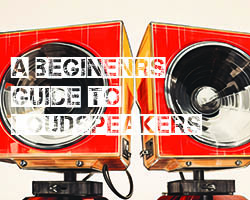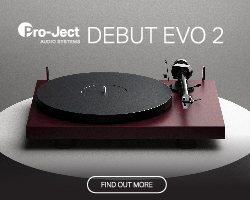TECHNICS SU-GX70 NETWORK AMPLIFIER REVIEW
HiFi PiG’s Stuart takes a listen to the Technics SU-GX70 Network Amplifier.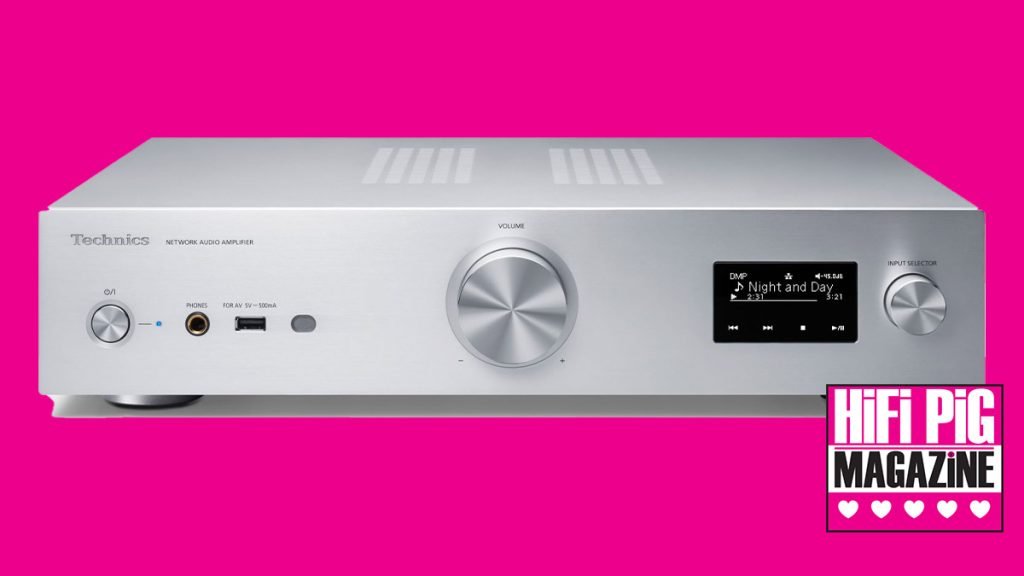
Regular readers will know I have a bit of a thing for this Japanese brand that goes way back in the annals of time to a dim and distant time when I was a teenager beginning to explore all things HiFi. I’m repeating myself, but for the uninitiated, I had a HiFi system bought for a birthday and/or Christmas that consisted of a Technics SLDL1 turntable and some Hitachi separates and speakers. I loved it! However, with the turntable came a catalogue of Technics kit of the day and I spent many an hour listening to my very limited record collection and poring over said catalogue and associated basalt plinths and amps with huge UV meters. Around the same time, I began to read the HiFi press of the day, and friends who had Dual, NAD, and KEF/Wharfedale systems would take the piss out of my system with cries of “Jap crap”. I was an impressionable teen and despite my thinking that my system sounded great, I fell into line and duly sold the Hitachi kit and bought a Musical Fidelity The Preamp, a Crimson Electric amplifier, and a pair of Wharfdale Diamonds. The turntable stayed, but I did spend my first term’s student grant on an LP12 (secondhand with no arm and no cartridge) And that’s how it remained (armless) until I swapped it and all my other stuff for a pair of MK2 Technics 1210s. In the mid-eighties, Japanese HiFi took a bit of a beating in the UK, and I suppose it was much like the influx of Japanese cars like Datsun – a good degree of xenophobia mixed up with a sprinkling of protectionism. It seems this has continued to a degree and I was speaking to Bruno at his HiFi shop in Quimper the other day about how one of the brands he sells (Yamaha) is perceived and he kind of echoed the same kind of thing I encountered and mentioned in the eighties. Let’s get one thing straight from the off, there is a lot of excellent Japanese HiFi out there and the first name that springs to mind with me is Technics.
Before I continue, I need to clarify a small matter for friends outside the UK. The correct pronunciation of Technics is not Techniques, it is TechniKs, though to be honest, all the Japanese folk I’ve met that work for Technics pronounce it incorrectly too. Perhaps another case of the rest of the world being wrong and English folk being correct?
So, now we have got the matter of Japanese audio kit not being inferior and the correct way to say Technics out of the way I suppose we ought to discuss the product that I’ve been charged with having a listen to, the evocatively named Technics SU-GX70 Network Audio Amplifier. To me, the name conjures the very essence of Japanese simplicity and simplicity and SU-GX70 is so much easier to recall than, for example, the Technics Cherry Blossom Amplifier.
I had an online meeting with a couple of guys from Technics about the amplifier and how it was conceived and born, and the initial thing that I thought was interesting was that the SU-GX70 (I’m just going to call it the amp from now on) was created to cater for shifts in consumer needs and desires, and with the main shift being away from predominantly video content to audio being more important, BUT having high-quality video content with the ability to connect audio bits and bobs to the television. The choices for a new amplifier and its functionality would be heavily influenced by these, presumably well-researched customer needs and wants with the intersection on the Venn diagram being a 2-channel amplifier that is compatible with being connected to the television. Now, I can almost see dyed-in-the-wool audiophiles reading that last statement and recoiling in horror, but the truth is that Joe Public wants both great visual content that is accompanied and enhanced by great audio content, and this amp aims to meet those consumer demands. Smart move Technics.
FEATURES OF THE SU-GX70 AMPLIFIER
The amp is designed to offer (and I quote) “Next level integration using Technics’ full digital technologies” and “The definitive living room audio centre that enables seamless enjoyment of video audio and music.”
And so what Technics have designed is a fully digital amp that will play back digital signals, be they streamed music or video via HDMI, that will be “high-purity” by eliminating jitter and noise. The amp is said to have uncompromised sound whether the end user is using streamed content via the “Grand Class” low-noise power circuit or through the onboard phonostage.
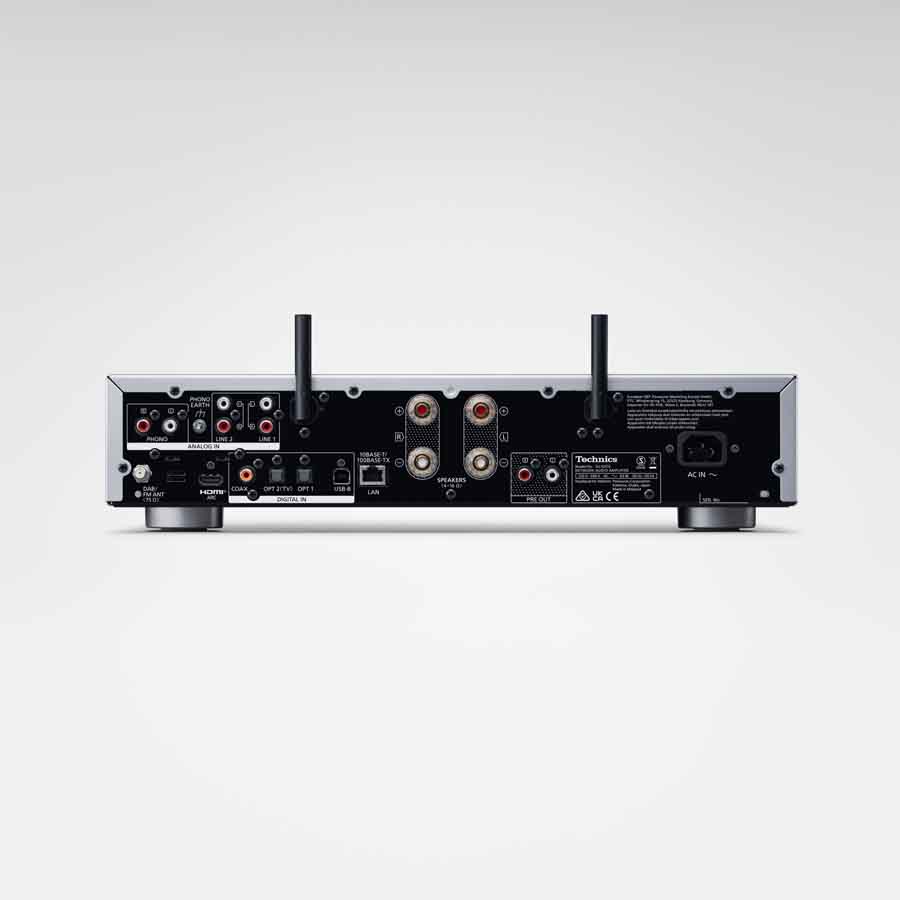
Well laid out makes the plethora of connections easy to get at
I’ll go through some of the onboard tech’ in a moment, but to me, the amp (available in silver or black) looks like proper HiFi, and by that I mean it looks like what anyone in the street would describe when asked to say what HiFi-separates look like. It’s unfussy and it just looks like what it is…and there’s a matching CD player the equally evocatively monikered SL-G700 to stack below it should you want to play your silver discs. Now, I really love this styling and whilst it’s not exactly ground-breaking, what it is is honest-looking – it’s not going to be confused for anything else other than a HiFi component whilst sat on your sitting-room sideboard, that’s for sure. The front panel is pretty self-explanatory and I don’t think I need to go into detail about there being a volume knob, headphone socket, and all the rest – there are photos to look at for that! The volume knob feels very well made and turns nicely and the input selector far right has a satisfying click to it.
Inputs-wise the amp is suitably well-specified and will connect to WiFi, Bluetooth, and Airplay for wireless fans. In addition to the wireless connectivity, there’s a phonostage input for moving magnet cartridges which I think is a sensible move, plus a couple of other RCA analogue inputs, which I also think are sensible additions. There’s an input for the included wire DAB/FM radio antenna which I also think is a useful thing to have – I still totally believe that radio is a very important part of our music mix. Speaker posts and a set of RCA pre-outs complete the back panel other than the all-important digital inputs which include USB-B, a couple of opticals, a coaxial input, and the HDMI ARC input. Apart from the wired LAN connection and the power inlet, that’s your lot. Everything is well laid out in sensible groupings and everything is of reasonable if workaday quality. There’s certainly nothing to complain about and overall, everything on this amplifier seems to offer good quality.
The remote is a pretty standard affair but matches the amp, covers all the necessary functions, and is quite large so that it’s easily operated and less likely to get lost.
This on a standard bit of furniture (or HiFi rack if you must) will look smart and purposeful and is perfectly proportioned to look like what it is and with enough functionality to act as the hub for your home entertainment system.
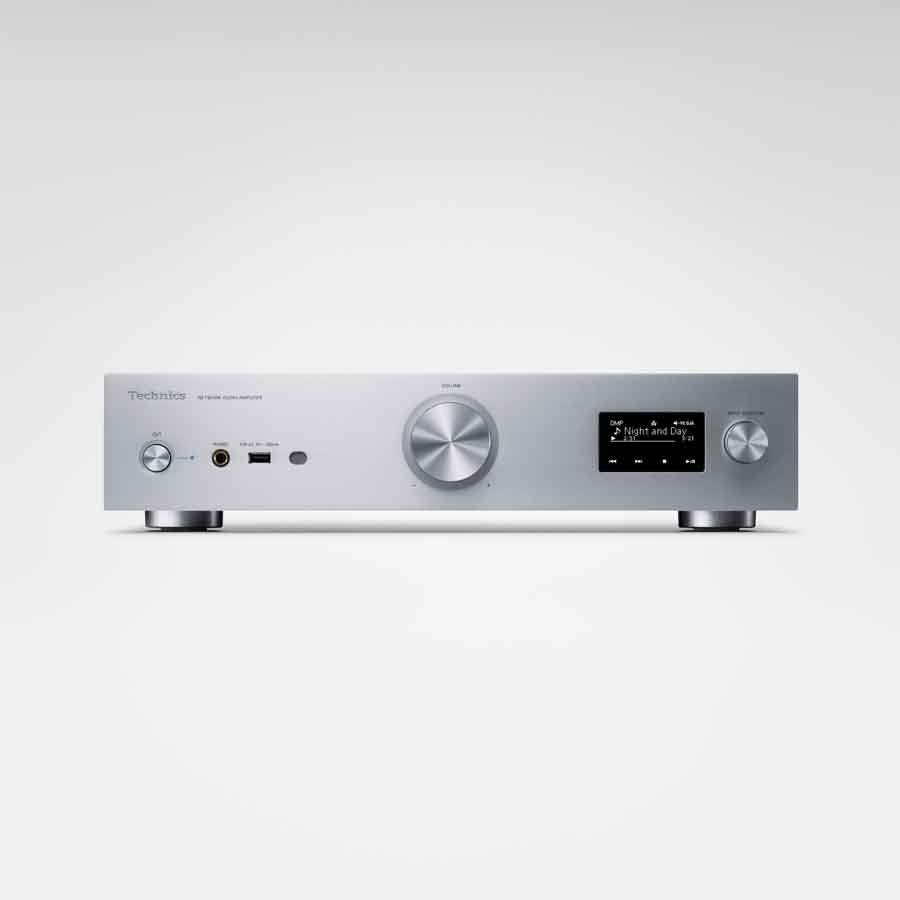
Like the back, the front of this amp is well laid out and feels like a quality product. The screen is small but gives you the info you need if you are close enough to read it
THE TECHNOLOGY
I’m not going to pretend to understand the tech’ inside this amplifier (or many others) and will go through the information I was given in our virtual meeting. There’s some clever stuff in here that does make sense, but from a science perspective, most of it is beyond my understanding. However, I do know that some readers enjoy this kind of thing and so here you are.
FULL DIGITAL AMP AND JENO (Jitter Elimination and Noise-shaping Optimisation) ENGINE
The guys I had the meeting with were keen to explain that the SU-GX70 is a fully digital amplifier and that means that its “digital transmission system processes signals fully digitally in all stages from input to output.” Technics say that this wholly digital approach offers more precise signal transmission and with less signal degradation caused by external noise when compared to analogue transmission. The JENO engine has also been used in the HDMI ARC channel and this is the first time Technics have used this. This process is said to reduce jitter during the transmission of digital signals (S/PDIF) and lead to better sound from TV Audio.
For those interested, the flow is as follows: 
LAPC CIRCUIT
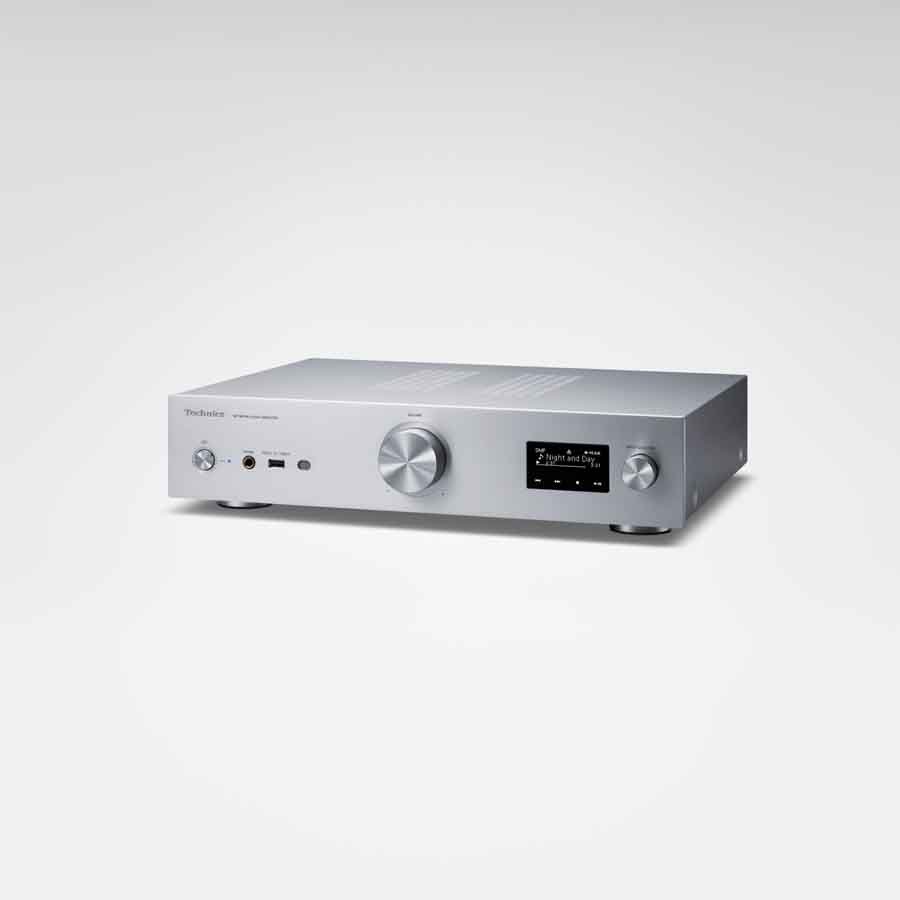
The knobs on the SU-GX70 have a great feel to them
My ears pricked up when this part of the amplifier was being talked about in our meeting and I genuinely found this quite interesting. Basically, this system and the algorithm measure frequency amplitude-phase characteristics of the amplifier with the speakers connected so that the frequency curve is flattened…. which must be a good thing! As a rule, the impedance of a speaker changes at different frequencies, but an amplifier is supposed to react consistently at all frequencies but that’s usually not the case in conventional amps.
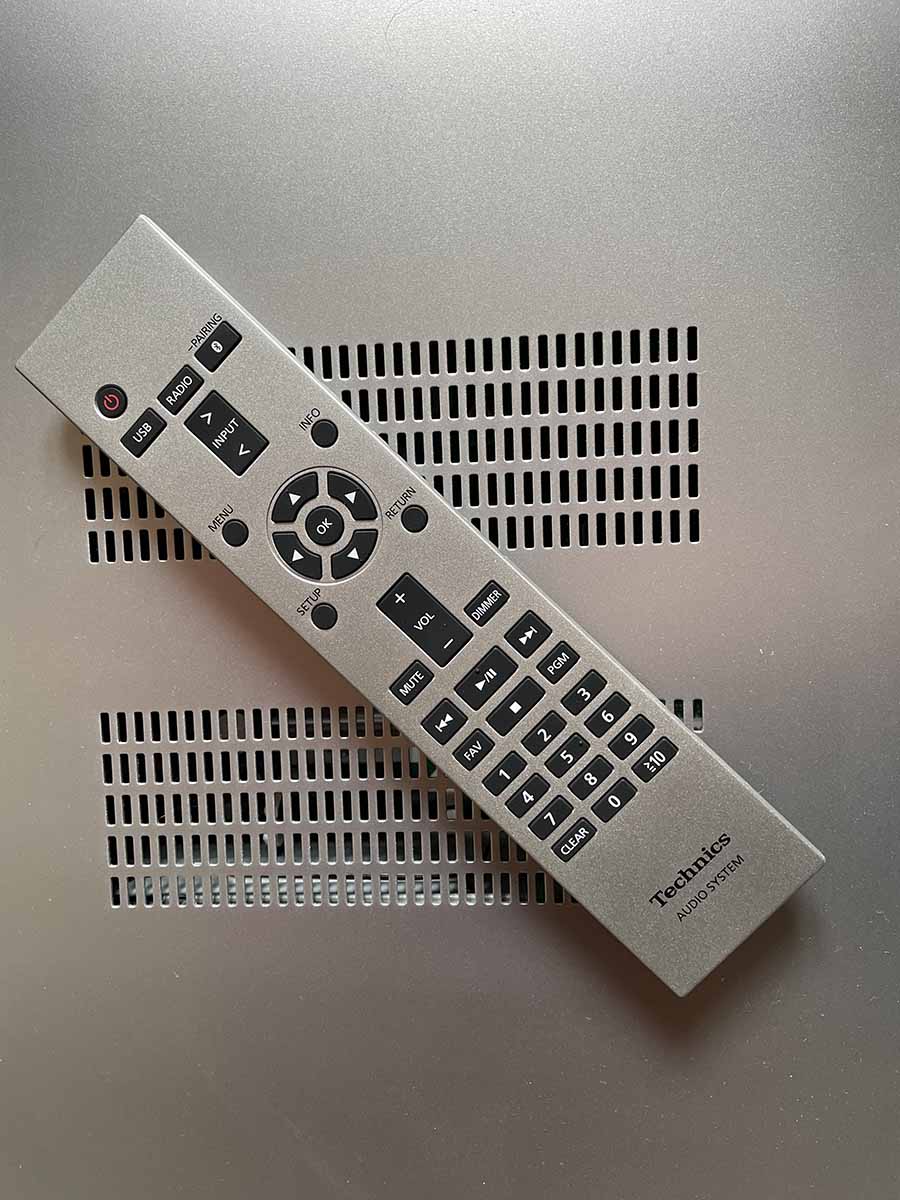
The remote matches the amp and is large. However, apart from volume, I barely needed to use it.
SPACE TUNE
This was another case of my ears becoming pricked (and not because I thought we were about to discuss some songs by Hawkwind) and I think we will see this type of system on more and more products in the coming years as more and more people realise that the room a system is placed in has a huge effect on the sound. There are essentially two ways to deal with room problems and they are either using physical products such as bass traps, diffusers, and absorbers (what we use at home) or through clever digital jiggery-pokery. There is an app (iOS only, sadly) called the Technics Audio Centre that allows users to select Free, Wall, Corner, or Shelf depending on where you can site your speakers in the room. This a limited to just four placements but does cover most bases. I actually think limiting the selection is fairly sensible given that infinite tweaking allows for infinite messing up! In addition to the SPACE TUNE feature, the app also allows for changing the L and R balance of the speakers. Essentially, what we have here is a set of in-app tone controls and balance controls.
Twin Power Supply Circuit System
Anyone who has even a passing interest in power amplifier design will be well aware of the importance that designers place on the power supplies within an amp. Technics have used a separate power supply for the power amplifier in the SU-GX70 that is wholly independent from other circuits in the amp. This is nothing new and many amplifier designs bast separate power supplies for individual parts of their amps.
High-Speed Power Supply
Again, I don’t think this is anything particularly different to what others are using but the SU-GX70 does use a high-speed (130kHz) switching power supply. Whether this speed of switch is higher than others I don’t know.
High-Quality Audio through Low-impact HDMI Video Output
The following is unique to Panasonic/Technics and once again I’m not going to pretend to understand what is going on and so will quote Technics.
“For the SU-GX70 to receive audio signals through the HDMI ARC (Audio Return Channel), due to the specifications, video signals must first be output from the SU-GX70. However, the output of these signals can cause unwanted noise. As such, the video signals are output from theSU-GX70 at a lower rate, and the digital value of the colour of each pixel is set to zero. This ensures low-load operation between the HDMI transmitting/receiving devices, preventing any unwanted noise generation from the video signals. This also reduces any impact on sound quality. Further, transmitting the signals from the TV to the JENO Engine via the shortest possible route minimises any further impact from jitter.”
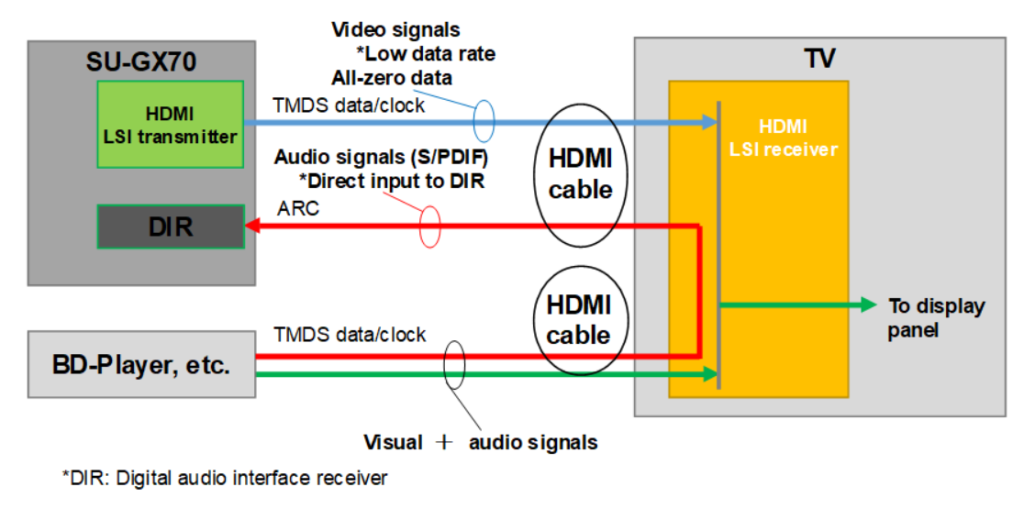
PURE AMPLIFICATION MODE
This I do understand, and it makes good sense. When this mode is employed, all power supply to the network and HDMI circuits are shut off completely. The idea here is again to remove noise from the system that could potentially and detrimentally affect the sound.
So that’s the techy stuff out the window and whilst there seems to be some pretty clever stuff going on in the amplifier, all that is pretty pointless if the unit doesn’t perform in the real world…so let’s have a play with it and whack some tunes and telly through it.
APP SETTINGS AND SOUND QUALITY
Just to clarify, I don’t give a monkey’s toss what technological wizardry is at play inside pretty much any product I have; be that a piece of audio equipment, mode of transport, computer, or kitchen appliance. What I do want from a product is for it to be fuss-free, reliable, and to perform its given duty to a high standard. If I buy a microwave, I want it to heat my dinner up quickly and ping me when it’s done. For the record, we don’t own a microwave, but you get my drift. If I buy an amplifier, I want it to be easy to fathom the functions on and to play music in an enjoyable fashion. So, all the above chatter about the tech’ may well be of interest to some of you, but for me, it’s a bit of an aside.
Anyway, let’s play some tunes.
For the duration of this review, I had the amp hooked up to a pair of Xavian Perla standmount speakers as they are about the kind of price I would expect this amp to be used with. Speaker cables were from Chord. I also tried the phonostage out using a Technics 1200MK2 and an Ortofon Concorde cartridge, again, because it’s the kind of thing I expect people that buy this to use.
The set up is simple and intuitive, though my manual didn’t have an English section…I’m certain those units intended for the UK and other English-speaking countries will have an English section – I used the French section, and it was simple to follow and sufficiently informative.
First up I tried the radio and attached the included wire arial that doubles for both FM and DAB radio. I knew DAB would be a pointless exercise as we just don’t get DAB stations here, but an auto-scan of the FM frequencies had me “enjoying” the 80’s delights that our local radio station insists on playing on heavy rotation. This was the only station I was able to get but this did not surprise me at all as we just don’t get very good reception in the valley in which we live. Mick Hucknall sounded just as I remember him sounding and reminded me why I don’t follow this particular artist. Now, many may scoff at the idea of including a radio receiver on an amplifier in the 21st century, but I think this is a very good idea, and for background listening it was excellent, despite the musical choices of RMN FM. The sound is very good for radio and the first thing that struck me was the excellent imaging. At this time, I hadn’t bothered to set up the network or set up the speakers with the Technics Audio Center App to optimize them…
To set up the speakers (and amp) you need to install both the Technics app and Google Home app, with both being completely new to me. However, the apps talk you through what to do with on-screen prompts and it’s all fairly intuitive. And once set up on the Google Home App the amplifier is seen by your phone/tablet and the Technics app. There was no shouting until the app refused to accept my Qobuz account details. I tried dozens of times but without success and I know I was adding the right info as I connected fine on my desktop. However, what immediately connected was all my home audio files housed on the NAS and I had all my music available through the app and with it all being dead simple to control. I’d have loved to have seen ROON compliance here, but I’m not so sure that the market for this is going to be Roon Ready themselves!
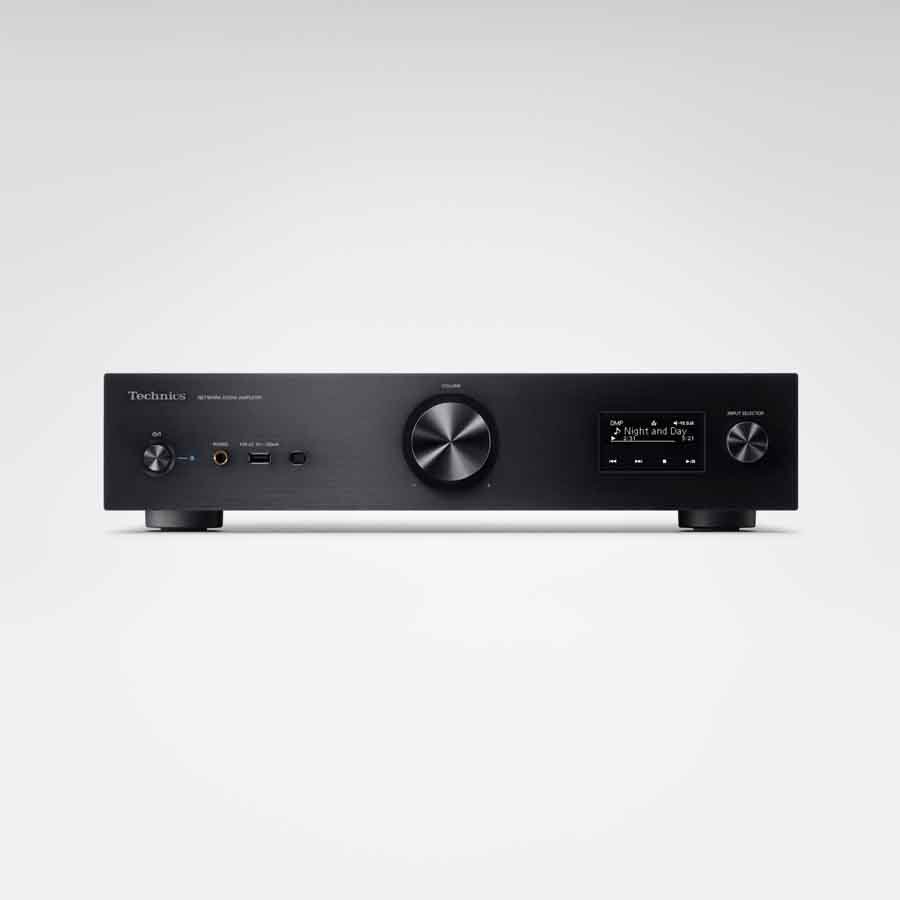
Also available in black
Once you are set up you can click on the tool icon on the Technics Audio Center and you can faff about with the balance with a slider control – the amp responds pretty much immediately and without much lag at all. Very cool. You can do likewise with the Tone controls (Bass and Treble).
Space Tune is pretty cool, and it does change the response of the speakers. What I did think useful was the inclusion of an L/R Custom setting that allowed you to change the setting for the left and right speaker so that if you have a speaker on a shelf and one stood in free space you can allow for this. This is a really useful feature and will allow your speakers to work as best they can in the room positions they find themselves in.
LAPC is pretty cool as well. Press set up and it goes through a little routine of playing test tones to measure whatever it is it is measuring. The process takes about four minutes, after which you shouldn’t have to fanny about with it. The cats didn’t like the test bursts. This is all very clever stuff – it allows you to get the best out of a pair of speakers and gets the amp working correctly with the speakers. Once it finishes the routine the music you were playing. You can turn it on and off so you can compare the sound with it on and off and it definitely sounded better with LAPC switched on with a more dynamic sound overall and a little more detailed.
There’s loads more you can do on the app that is interesting should you need (or want) to use it. These features include Pure Amplification (more on that in a bit), MQA Decoding (mmmm…), you can change the phase of all the analogue inputs including the phono input, and you can turn a subsonic filter on or off on these channels too. In addition to playing with the sound settings, you can also change what source you are using on the amp; for example, you can switch from streaming to radio or any other input you fancy. The app did stall a few times with me needing to close it and open it up again between switching sources, but otherwise, it performed very well, and I liked the unfussy and intuitive interface.
Overall, I enjoyed the app a great deal with a couple of niggles. Long story short was that I barely bothered to pick up the remote other than for volume which (unless I completely missed it) the app doesn’t seem to include. The display on the amp is about as much use as a chocolate fireguard for me and my old eyes when sat in the listening position and you do have to be pretty close to it to make out what it says – never mind, all that’s on the app anyway and I do think screens on amps are pretty much redundant most of the time.
Playing tunes off the NAS I have absolutely no questions that this is a very good sounding amplifier. How much of this has to do with the technical doodaddery I spoke about above I don’t know (nor care), but once set up I found this little system to be brilliantly punchy and enjoyable. What I particularly enjoyed was the way the amp got the speakers to play bass. This aspect of the sound was excellent listening to Jay Z’s first album and was a very enjoyable experience with that bass being as tight as you like. I also enjoyed the soundstaging of this amplifier with these speakers with this record, and even sat off-axis (with the balance set accordingly) I was able to enjoy the stereo effect. Even with the balance set centrally the sweet spot appeared to be quite wide. I loved being able to play with the balance and I wish it were available on more amps.
Crank the volume up to loud levels and you are left with a very balanced sound with just the volume getting louder, if that makes sense. This last point sounds a bit obvious but quite often the character of an amp/speaker combo can change as the volume gets higher – this doesn’t happen with the Technics amp and it remains even up to the point of pushing the amp beyond its limits (way too loud).
Bluetooth just works; switch to Bluetooth in the app, find the speaker on your tablet, and play YouTube or whatever. Music! Actually, I was quite surprised by the sound I got from the less-than-sonically-spectacular YouTube and I found the same punchy and enjoyable character of the amp I’d experienced before to come through. This is a good thing and I can see a good few folk that buy this using Bluetooth quite a bit. I have absolutely no niggles at all with regard to Bluetooth playback, setup, or sound. Actually, I’d go as far as to say that this is as good as I’ve heard YouTube sound when streamed via Bluetooth. Listening to The Grateful Dead’s Touch of Grey I was still able to hear the spatiality of the mix and the sounds of the crowd that are plumbed into the official video. This being able to identify sounds in a mix (even with Bluetooth) is impressive and has to be something to do with the whole LAPC and Space Tune thing. Purists will scoff, I’m sure, but the truth is that the people that are in the market for this kind of amplifier really don’t give a flying-fist-of-funicular-fun™ whether the amp is behaving as a true straight wire with gain or not! What they do care about is that the sound coming out of the speakers is good and that it is FUN! And the sound I got with this amp and the Xavian speakers was certainly great fun!
The phonostage on this amp is excellent in my opinion. I played a good few records through the amp using the Ortofon Concorde and Technics 1210MK2 combo and that spatial element of the amplifier’s character was maintained on everything I played. The phonostage also allowed the same natural separation of instruments in the mix – bass was easy to pick out from the mix as were the vocals and other instruments and where they sit in the mix. For the level of record player and cartridge most will use with this amplifier, I don’t see anyone having any cause for complaint! There’s plenty of detail and punch as there was with the amp streaming content.
The headphone amp worked fine for the short test I gave it.
NIGGLES
I couldn’t get the app to connect to my Qobuz account.
The app hung a few times between changing inputs and needed to be restarted – not a major hassle if truth be known.
Couldn’t find volume on the app.
CONCLUSION
This is a very fine-sounding amplifier that will appeal to those that want an amplifier that looks like a traditional bit of HiFi but one that has also been brought into the twenty-first century.
It has excellent connectivity and the onboard bits and pieces by way of clever tech and algorithms work well and are not just there to give the sales bod something to yadder on about when selling this amp to punters.
This amplifier is not aimed at purists, and it is not aimed at the hair-shirt audiophile brigade! Those two groups may well rail against the LAPC and Space Tune features, BUT the truth is that the people that this amplifier is aimed at will “get” it and will not care about what makes it sound good, so long as it does.
And this amplifier does sound good! In fact, I’d say it sounds very good using the speakers I paired it with. The characteristics are a wonderfully spatial sound with clear lineation of instruments within the mix being evident. There is punch, detail, and an overall feeling of rightness. I don’t think it sounds at all digital or harsh in any way, and I’d actually say it sounds natural and clean.
The Technics SU-GX70 will be bought in numbers by those people who are looking for a fuss-free way to enjoy music in their living rooms and I think they will be very (VERY) happy with their purchase. Not only does the amplifier allow for the connection of a massive array of sources including a turntable, but it also has onboard radio, a DAC , DAB radio, and a headphone amp.
This is a traditional integrated amplifier brought up to date and I loved my time with it!
Had the app worked flawlessly this amp would have got our top award, but it didn’t and the amp loses points on that basis.
AT A GLANCE
Features and Build Quality:
The amp is well finished if nothing outrageously extravagant
It’s hard to knock the amp with regard to connectivity
The app is good and easy to set up but it didn’t allow me to connect to my Qobuz account and it did hang a couple of times
The app allows for a great deal of set up by the user to allow for their room and their preferred sound
Sound Quality:
Punchy and fun
Great soundstaging and separation of instruments in the mix
Value For Money:
This is likely at the upper end of what a causal user would want to spend but if they do they will be richly rewarded. I’d envisage folk looking at his being those that think they have outgrown their soundbar but don’t want to commit to a full-on surround system.
We Loved:
Great looks, great features and a surprisingly excellent sound
We Didn’t Love So Much:
Not being able to connect to my Qobuz account was frustrating
Elevator Pitch Review: The Technics SU-GX70 network amplifier is designed to be the digital hub for your home and connect the dots between audio and video sound playback. It performs almost faultlessly and sounds punchy and refined, whilst remaining great fun to listen to. The big selling point of this amplifier is the ability of the onboard wizardry to get the best out of the speakers you choose to partner it with and these features work excellently.
Price: £ 1699 $1995

Stuart Smith
NB: I have spoken to Technics about the Qobuz issue and they have sent me screenshots of Qobuz connected along with images of the volume control on the app…so it is there.
SPECIFICATIONS
Output Power
40W+40W(1kHz,T.H.D.1.0%,8Ω,20kHz LPF) / 80W+80W(1kHz,T.H.D.1.0%,4Ω,20kHz LPF)
FTC Output Power
30W + 30W ( 1kHz, T.H.D. 1.0%, 8Ω, 20kHz LPF ) / 60W + 60W ( 1kHz, T.H.D. 1.0%, 4Ω, 20kHz LPF )
Load Impedance
4Ω-16Ω
Frequency Response
PHONO (MM): 20Hz – 20kHz ( RIAA DEVIATION ±1dB, 4Ω ) / LINE:20Hz – 40kHz ( -3dB, 4Ω ) / DIGITAL: 20Hz – 80kHz ( -3dB, 4Ω )
Input Sensitivity / Input Impedance
PHONO (MM): 2.0 mV / 47 kΩ / LINE: 200 mV / 23 kΩ
Analogue Input Terminal
LINE x 2 / PHONO (MM) x1
Digital Input Terminal
Optical digital x2 / Coaxial digital x1 / USB-A x1 / USB-B x1
Analogue Output Terminal
PRE OUT x1
Digital Output Terminal
HDMI ARC
Headphone Output
Yes, Stereo Φ6.3 mm (1/4″)
USB-A: iPod/iPhone/iPad
No
USB-A: Support Codec
Yes (32, 44.1, 48, 88.2, 96, 176.4, 192, 352.8, 384 kHz / 16, 24, 32 bit)
USB-A: Support Codec FLAC
Yes (32, 44.1, 48, 88.2, 96, 176.4, 192, 352.8, 384 kHz / 16, 24 bit)
USB-A: Support Codec DSD
Yes (2.8 MHz, 5.6 MHz, 11.2 MHz)
USB-A: Support Codec AIFF
Yes (32, 44.1, 48, 88.2, 96, 176.4, 192, 352.8, 384 kHz / 16, 24, 32 bit)
USB-A: Support Codec ALAC
Yes(32, 44.1, 48, 88.2, 96, 176.4, 192, 352.8, 384 kHz / 16, 24 bit)
USB-A: Support Codec AAC
Yes (32, 44.1, 48, 88.2, 96 kHz/16-320kbps)
USB-A: Support Codec MP3
Yes (32, 44.1, 48 kHz / 16-320 kbps)
PC(USB-B)
USB 2.0 High-speed / USB Audio Class 2.0, Asynchronous mode
PC(USB-B) Support Codec LPCM
Yes (32, 44.1, 48, 88.2, 96, 176.4, 192 352.8, 384 kHz / 16, 24, 32 bit)
PC(USB-B) DSD control mode
ASIO Native mode, DoP mode
MQA Decorder
Yes
LAN(DMR) WAV
Yes (32, 44.1, 48, 88.2, 96, 176.4, 192, 352.8, 384 kHz / 16, 24, 32 bit)
LAN(DMR) FLAC
Yes (32, 44.1, 48, 88.2, 96, 176.4, 192, 352.8, 384 kHz / 16, 24 bit)
LAN(DMR) DSD
Yes (2.8 MHz, 5.6 MHz, 11.2 MHz)
LAN(DMR) AIFF
Yes (32, 44.1, 48, 88.2, 96, 176.4, 192, 352.8, 384 kHz / 16, 24, 32 bit)
LAN(DMR) ALAC
Yes (32, 44.1, 48, 88.2, 96, 176.4, 192, 352.8, 384 kHz / 16, 24 bit)
LAN(DMR) AAC
Yes (32, 44.1, 48, 88.2, 96 kHz/16-320kbps)
LAN(DMR) MP3
Yes (32, 44.1, 48 kHz / 16-320 kbps)
Ethernet Interface
LAN (100BASE-TX/10BASE-T)
Wi-Fi
LAN (100BASE-TX/10BASE-T)
Chromecast built-in
Yes
AirPlay 2
Yes
Bluetooth® (Support codec)
Yes (AAC, SBC)
Tuner
FM
Power Supply
AC 120 V ,60 Hz
Power Consumption
63W
Accessories
AC Cord, FM Indoor Antena, Remote Control, Batteries for Remote Control, Owner’s Manual
Dimensions
(16-15/16 x 3-55/64 x 14-31/64)inch
Weight
Approx. 14.6 lbs
























































